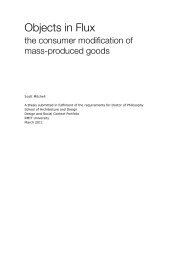Making Memory Space: Recollection and Reconciliation in Post ...
Making Memory Space: Recollection and Reconciliation in Post ...
Making Memory Space: Recollection and Reconciliation in Post ...
You also want an ePaper? Increase the reach of your titles
YUMPU automatically turns print PDFs into web optimized ePapers that Google loves.
attachment to human rights, mutual respect <strong>and</strong> democracy, <strong>and</strong> help prevent these ever<br />
aga<strong>in</strong> be<strong>in</strong>g violated. 41<br />
To this end, the Truth <strong>and</strong> <strong>Reconciliation</strong> Commission was established, to (among other th<strong>in</strong>gs) br<strong>in</strong>g<br />
personal memory to the fore <strong>and</strong> from it establish a collective unity. It was designed <strong>in</strong> the hope of<br />
replac<strong>in</strong>g ‘entrenched visions of society <strong>and</strong> conceptions of self based <strong>in</strong> legislated difference <strong>and</strong><br />
police separation, with the construction of a new social order grounded <strong>in</strong> <strong>in</strong>clusion, democratic<br />
representation <strong>and</strong> unity, while still nurtur<strong>in</strong>g <strong>and</strong> valu<strong>in</strong>g diversity <strong>and</strong> difference.’ 42 As part of this<br />
reconciliatory approach, official <strong>in</strong>stitutions of the state were called upon to assist <strong>in</strong> the facilitation of<br />
new narratives <strong>and</strong> the construction of memory <strong>in</strong> a way that would acknowledge their place as a liv<strong>in</strong>g<br />
entity <strong>in</strong> the society. 43<br />
The Truth <strong>and</strong> <strong>Reconciliation</strong> Commission (TRC)<br />
The Truth <strong>and</strong> <strong>Reconciliation</strong> Commission (TRC) was largely based on the Chilean commission that<br />
was established to determ<strong>in</strong>e crimes under the military junta between 1970 <strong>and</strong> 1990, called the<br />
Comision National para la Verdad y la <strong>Reconciliation</strong>. The TRC <strong>in</strong> South Africa was <strong>in</strong>vestigat<strong>in</strong>g<br />
human rights violations that occurred between 1960 <strong>and</strong> 1994; hear<strong>in</strong>gs began <strong>in</strong> 1996. The hear<strong>in</strong>gs<br />
were a national project based around the notion that the act of tell<strong>in</strong>g the past would facilitate<br />
commonality <strong>and</strong> heal<strong>in</strong>g for all South Africans, <strong>and</strong> the recollection <strong>and</strong> the break<strong>in</strong>g of silence would<br />
‘heal the country, re-establish the state <strong>and</strong> construct the nation <strong>in</strong> a moral universe.’ 44 The TRC was<br />
empowered to grant amnesty to any full disclosure of human rights abuses where political motivation<br />
could be proven, with the hope that this would encourage the ‘truth’ to come out while reconcil<strong>in</strong>g<br />
perpetrator <strong>and</strong> victim. 45 Such an approach situates memory <strong>and</strong> recollection at the centre of national<br />
forgiveness <strong>and</strong> progression, <strong>in</strong> the hope that <strong>in</strong>dividual memories will give way to a form of collective<br />
memory, which will allow the country to move forward. Consequently, critical narratives <strong>in</strong> the<br />
emergent social, political <strong>and</strong> cultural identity of a new South Africa were based around the act of<br />
remember<strong>in</strong>g <strong>and</strong> forgett<strong>in</strong>g.<br />
The TRC succeeded <strong>in</strong> articulat<strong>in</strong>g the <strong>in</strong>dividual hurt of some of the population <strong>and</strong> forced many to<br />
acknowledge the trauma <strong>in</strong> their midst. But, <strong>in</strong> seek<strong>in</strong>g commonality <strong>and</strong> draw<strong>in</strong>g broad analogies<br />
between <strong>in</strong>dividual testimonies, the creation of shared recollection arguably underm<strong>in</strong>ed the unique<br />
specificity of <strong>in</strong>dividual commentary. In many respects the TRC forms the basis for memory practice <strong>in</strong><br />
41 Gerard Corsane, ‘Transform<strong>in</strong>g Museums <strong>and</strong> Heritage <strong>in</strong> <strong>Post</strong> Colonial <strong>and</strong> <strong>Post</strong> Apartheid South Africa: The Impact of<br />
Processes of Policy Formulation <strong>and</strong> New Legislation’, Social Analysis, Volume 48, Issue 1, Spr<strong>in</strong>g 2004 (New York <strong>and</strong> Oxford:<br />
Bergnahn Books, 2004), p.6.<br />
42 Charma<strong>in</strong>e McEachern, Narratives of Nation: Media, <strong>Memory</strong> <strong>and</strong> Representation <strong>in</strong> the <strong>Mak<strong>in</strong>g</strong> of the New South Africa<br />
(New York: Nova Science Publishers Inc, 2002), p.xi.<br />
43 Janet Hall, Op cit, p.175.<br />
44 Charma<strong>in</strong>e McEachern, Op cit, p.xv.<br />
45 Br<strong>and</strong>on Hamber <strong>and</strong> Richard Wilson, Op cit, p.2.<br />
20
















